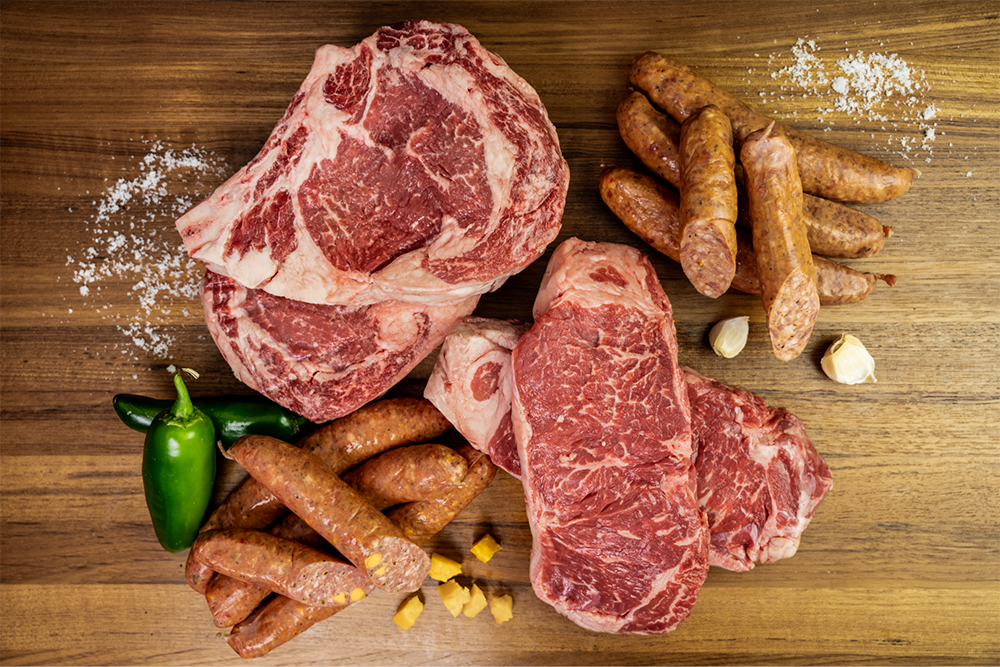Check Out the Regional Taste at Bagley Farms Meat Market Edwardsville IL: Fresh and Delicious
Check Out the Regional Taste at Bagley Farms Meat Market Edwardsville IL: Fresh and Delicious
Blog Article
Discover the Art of the Butcher's Cut in a Modern Meat Market
In the ever-evolving landscape of modern-day meat markets, the butcher's cut has actually transcended its standard origins, combining olden craftsmanship with contemporary techniques. bagley farms meat market edwardsville il. Today's butchers are not just cpus of meat; they are knowledgeable craftsmens that highlight sustainability and ethical sourcing. Their knowledge in selecting and preparing cuts customized to particular culinary requirements offers an unequaled eating experience. What absolutely establishes the modern-day butcher apart is their capacity to create a deeper link between customers and the origins of their meat. How do these masters equilibrium practice with advancement, and what implications does this have for the future of meat intake?
Advancement of Butchery Techniques

The mid-20th century saw butchery strategies better improved by clinical insights into muscular tissue biology and meat aging, improving both tenderness and taste. Innovations like vacuum cleaner product packaging and refrigeration prolonged product shelf-life, allowing butchers to expand offerings and improve quality assurance. This period additionally marked the rise of specialized equipment, such as band saws and meat slicers, which raised accuracy and effectiveness in meat processing.
Electronic systems currently help in monitoring animal provenance and enhancing cuts to meet certain customer preferences. Furthermore, a revival in artisanal butchery has actually arised, blending typical skills with contemporary expertise to cater to consumers seeking honest and lasting meat options.

Comprehending Meat Cuts

Recognizing the ins and outs of meat cuts is vital for both butchers and consumers looking for quality and worth. For butchers, exact cuts reflect ability and respect for the craft, ensuring marginal waste and optimal return.
The main groups of meat cuts consist of primal, sub-primal, and retail cuts. Primitive cuts, such as the loin, rib, and chuck, are the big sections originally separated from the carcass. Butchers after that break these down better into sub-primal cuts, prior to finally generating retail cuts available to consumers, like ribeye or tenderloin. Each stage needs cautious interest to anatomical structure and muscular tissue composition.
Comprehending muscular tissue composition is critical; muscles utilized much more regularly by the animal have a tendency to be harder and are best matched for slow cooking approaches, while less-used muscles, like those found in the loin, are extra tender and suitable for barbecuing or roasting. Knowledge with these distinctions empowers consumers to make educated selections, boosting their culinary ventures.
Picking Top Quality Meat
Picking the ideal meat includes more than simply choosing a visually enticing piece from the display. The art of picking top quality meat needs a critical eye and understanding of particular attributes that indicate freshness and excellence.
Second of all, take into consideration the marbling, which describes the white streaks of fat within the muscle. Correct marbling is an essential indication of inflammation and taste, as it melts throughout cooking, enhancing the meat's juiciness. Bear in mind, higher marbling usually correlates with exceptional high quality cuts, such as USDA Prime.
Texture is one more critical factor; meat ought to feel strong to the touch, not slimy or excessively soft. Additionally, be conscious of the scent. Fresh meat more must have a tidy, neutral smell, cost-free from any sour or repulsive smells.
Matching Cuts With Food Preparation Methods
Effectively coupling cuts of meat with the suitable food preparation methods is crucial for achieving ideal taste and texture. Different cuts differ in inflammation, marbling, and connective cells content, each calling for specific methods to open their possibility. Tender cuts like filet mignon and ribeye, with their fundamental marbling, advantage from high-heat, quick-cooking methods such as grilling or pan-searing. These techniques improve the meat's all-natural tastes and make certain a juicy finish.
Conversely, tougher cuts like brisket and chuck roast are rich in collagen, which damages down right into jelly when prepared slowly. These cuts are suitable for braising or sluggish roasting, enabling the meat to soften gradually and establish deep, complicated flavors. Cuts such as short ribs and pork shoulder fare well with slow-cooking methods, where prolonged cooking times transform their robust appearances right into delicious dishes.
Lamb shanks and oxtail, which require long term food preparation to tenderize, are excellent prospects for cooking or sluggish simmering. These methods coax out rich, passionate flavors while maintaining dampness. By recognizing the special characteristics of each cut, cooks and home cooks alike can elevate their culinary productions, making certain each meal is both satisfying and remarkable.
The Butcher's Duty Today
Browsing the progressing landscape of the contemporary meat market, the butcher's duty today prolongs beyond plain preparation of cuts. Contemporary butchers are cooking artisans, instructors, and supporters for lasting practices. They link the space in between the farm and the fork by ensuring honest sourcing, understanding pet husbandry, and prioritizing transparency in the supply chain. This change shows the expanding consumer need for quality over amount, where provenance and animal well-being are paramount.
In addition to crafting accurate cuts, butchers currently involve directly with customers, using cooking suggestions and tailoring selections to fit specific needs and choices. Their knowledge in meat aging, marbling, and taste accounts empowers consumers to make enlightened choices, improving their cooking experiences. This customized solution exhibits the butcher's advancing duty as a trusted consultant in the kitchen.
Additionally, butchers are crucial in reducing waste, using entire pets to develop varied items such as sausages and stocks - bagley farms meat market edwardsville il. This comprehensive technique not just values the pet yet also aligns with contemporary sustainability goals. In this method, the contemporary butcher embodies both tradition and development, adapting to an ever-changing market while protecting the creativity and stability of their craft

Conclusion
The modern butcher's craft intricately weaves typical methods with modern technologies, highlighting sustainable techniques and honest sourcing. Proficiency in comprehending diverse meat cuts and top quality signs empowers butchers to give educated referrals, lining up specific cuts with optimum cooking approaches. This competence not only boosts culinary experiences yet also reinforces the connection in between customers and the origins of their food. a knockout post By recognizing look at here historical techniques while embracing modern demands, the butcher's duty remains crucial in today's sophisticated meat market.
Report this page